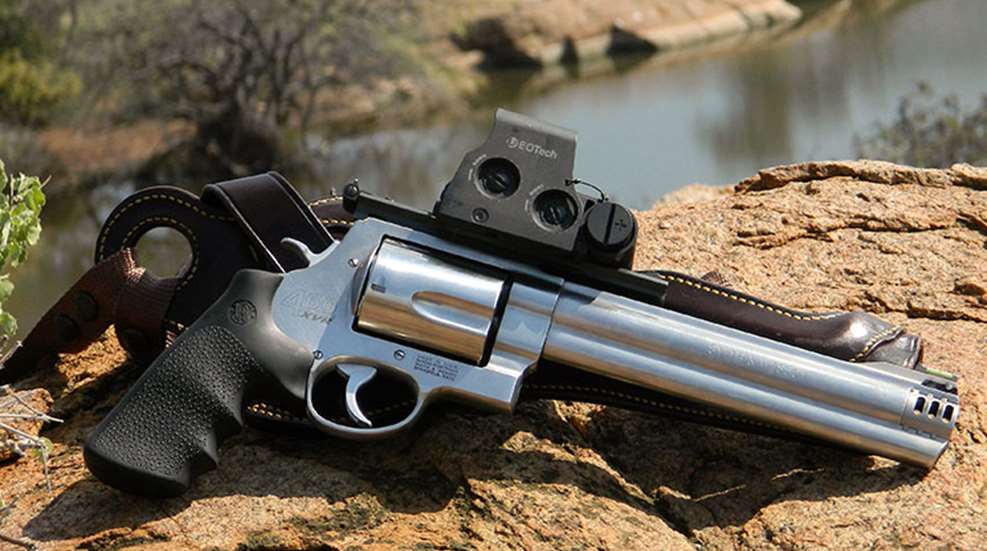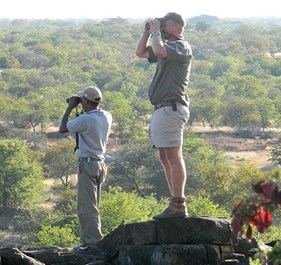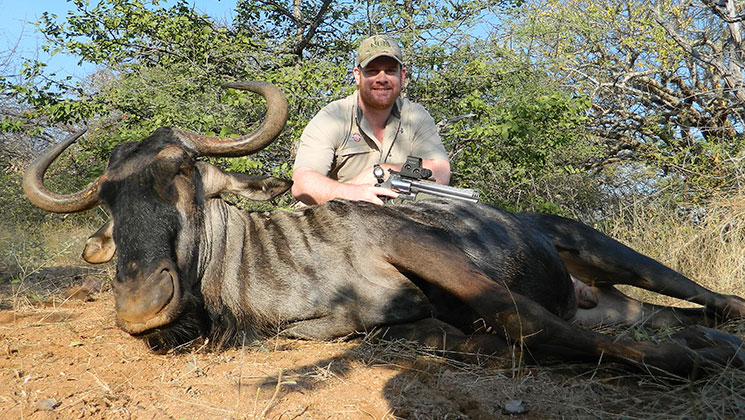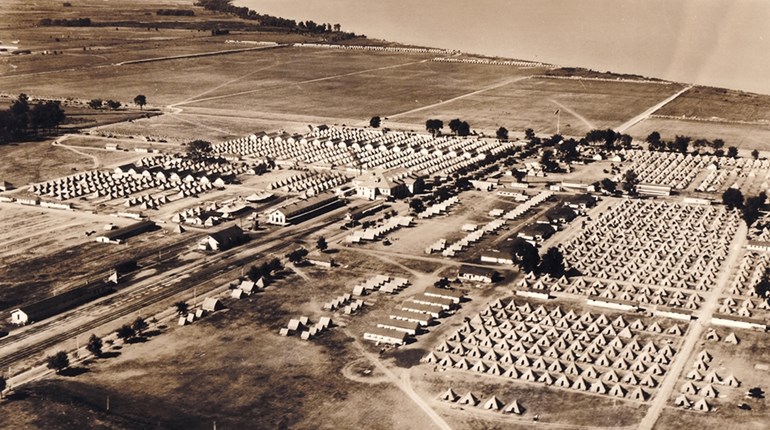
“You must be ready, and be quick,” cautioned Leo, my professional hunter and constant companion during the week-long hunt. “I think those revolvers are a bit slower than a rifle,” he added.
I had to agree with him. It was no fault of the handgun itself, it’s just that prior to this hunt, my first in Africa, I’d always carried a rifle in pursuit of wild game. The revolver—a Model 460XVR in .460 S&W Mag. with an 83/8-inch-long barrel—was actually one of the finest firearms I’d ever shot. But the gun packs a wallop, both for the target and the shooter. And though I’d practiced hard in preparation for the trip, as my bruised hands could attest, settling the gun onto sticks and holding a steady sight picture was still nowhere near as easy, or instinctive, as shouldering a rifle.
We were settled into a natural blind overlooking a waterhole, a position we’d occupied since about 3:30 p.m. Now, two hours later, we remained well-concealed behind the large rocks and thick brush, but each of us—myself, Leo and the trackers, Nison and Lukas—made our own silent preparations as the day’s last light began receding from the horizon. We’d seen sign of eland, kudu and wildebeest, but none of us could be sure of what might come in for an evening drink. As I checked and rechecked my gun and the glowing reticle of its EOTech sight, I could feel the trackers tense with anticipation.
They’d heard something. A quick look between the pair confirmed their individual suspicions, and Nison eased higher in his perch and scanned the area with binoculars. He whispered something to Lukas and made an arcing movement with his hand. “Wildebeest,” Leo translated, keenly aware of the interactions between his trackers, “coming fast,” he added, indicating their direction of approach. In a motion I was up and on the sticks, scanning the banks of the small pond. As if on cue a herd of a dozen or more blue wildebeest approached faster than I could prepare. The moment had arrived. In a breath’s time I found my target, cocked the hammer and began to press the feather-light trigger. The shot broke, and instantly my world erupted into the push of recoil, the gun’s deafening report, clouds of dust and the thunder of hooves.
■■■
I had just deplaned in Atlanta’s Hartsfield-Jackson airport when I learned that I would be joining a small group organized by Smith & Wesson for a trip to South Africa. The assignment was a plains game hunt with the company’s X-frame revolvers. As the news set in, and I walked toward the departure gate for my connecting flight home, I realized I was in for a great adventure and a great challenge. This would be not only my first time stalking the African bush, a pursuit I’d only read about in stories from Aagaard, Capstick and Ruark, but also my first hunt with a handgun, and a monstrous one at that.
During the intervening months, appropriate paperwork had to be completed, gear had to be assembled and I had to prepare myself to take on the hunt of a lifetime with a firearm with which I was a relative novice. I worked hard and spent hours on the range, not just sighting-in the .460 S&W Mag., but becoming proficient and accurate.
For starters, the trigger had to be mastered. It possessed a smooth, though very heavy double-action pull weight of 13 pounds, and a light 4-pound single-action pull. I needed to be comfortable with both. I started on the bench shooting 50-yard groups and decided that, for me, cocking the hammer and firing single-action was preferable. The double-action trigger press needed to draw back the heavy hammer often produced unacceptable wobble in my sights. I practiced from sandbags until 2- to 3-inch three-shot groups became the norm. To say the revolver is a shooter would be an understatement; I never came close to maximizing its inherent mechanical accuracy. The punishing recoil often required me to set down the gun and take a break after just a few shots, not because of the kick itself—I could handle the pain in my palms and wrists—but because I wanted to ensure I did not develop a miss-inducing flinch. (Anticipation of recoil and muzzle rise can manifest itself as premature downward pressure on the gun.) Anytime I started trying to predict the trigger’s break, or if my muscles began to tense before the shot broke, I simply set down the gun and took a breather.
When I gained some skill and confidence with the gun from the bench, I upped the challenge and started shooting from sticks. From there I progressed to practicing quickly getting the gun up on the sticks from a low ready, and eventually incorporated drawing from the Alaskan-style chest holster, mounting the sticks and taking the shot. I even spent time practicing a full transition from walking, gun holstered and sticks in hand, to shooting, sticks deployed and a round on target. Though I knew I would be ready and vigilant while hunting, I was determined not to be caught fiddling with my gear should a fleeting opportunity arise.
■■■
Through the rising din I could just make out the solid-sounding whack that usually accompanies a good body shot. Of course the sound is by no means a guarantee, but nonetheless many hunters bend their ears straining for that audible confirmation of impact. A quick glance to Leo confirmed he agreed. “Good shot,” he said. “You got him good.”
Him? I realized that in the lightening-fast encounter, I hadn’t consciously taken time to discern male from female, or decipher horn size. Instead, a combination of instinct and luck—and, I’m sure, an ingrained obedience to the PH’s instruction—had guided my aim to a nice bull that paced the rear of the herd as the females bowed their heads to drink.
As the last of the animals disappeared into the bush, I vainly tried to calm my adrenaline-fueled nerves and jittery hands in order to survey the field and piece together the order of events. The herd had veritably charged into view, about 70 yards out from our 10 o’clock. They’d come in to drink from the far bank of the pond, stopping at about 30 yards, dead in front of us. My bull had been behind, perhaps 45 to 50 yards distant at about my 11 o’clock, and angled just a few degrees less than broadside.
I replayed the shot in my mind, and waited for Leo to “smoke a long cigarette”—a familiar stateside custom meant to allow wounded animals to settle, nearby, I hoped, and expire. I should have known that he, and Africa, had different plans.
■■■
 The flight from Atlanta to Johannesburg, South Africa, was about 12 hours, and was followed in quick succession by a 45-minute puddle-jumper flight to the city of Polokwane in the country’s Limpopo province. From there, a three-hour drive delivered us to the gates of Maroi Conservancy, the base for our seven-day hunt.
The flight from Atlanta to Johannesburg, South Africa, was about 12 hours, and was followed in quick succession by a 45-minute puddle-jumper flight to the city of Polokwane in the country’s Limpopo province. From there, a three-hour drive delivered us to the gates of Maroi Conservancy, the base for our seven-day hunt.
Situated along the southern bank of the Limpopo River—also the boundary between South Africa and Zimbabwe to the north—Maroi Conservancy began as a conglomeration of several citrus farms under the proprietorship of Hannes Nel. With a passion for hunting, fishing and conservation, Nel borrowed money from his farming operation to establish a sustainable safari operation that encompasses around 21,000 acres of mopani trees, bushveld and tributaries that feed the farms and cultivated areas, as well as the Limpopo itself. It’s a family-run business, with Nel’s wife and children handling different facets of the operation. It’s been a successful venture thus far; Hannes was eager to point out that the original loan from his farms had been paid back after just a few years of safaris.
Maroi is a full-time, full-service operation with comfortable accommodations, excellent food, and resourceful guides, trackers and game processors. During my stay I was lodged in a semi-permanent tent with a canvas roof, wooden frame and full three-piece bathroom. All our meals were taken outside, whether it was morning coffee in the gazebo or dinner in the covered dining/bar area. A typical day began around 5:30 a.m. with a light breakfast and coffee, and we would begin hunting by 7:30. From noon to 3 p.m. we had a bit of a siesta, avoiding the midday heat and taking lunch, and the hunt would resume until around 6:30, followed by dinner and refreshments.
■■■
“Come! Come!” Leo shouted over his shoulder as he barreled down from our blind toward the water. Only a few seconds had passed between the shot and the hot-footed pursuit of the guide and trackers. It was another second, still, before I realized there would be no long cigarette this evening; the animal was struck, the chase was on and I was a part of it. On the far side of the pond, Leo checked the chamber of his .308 Win. bolt-action rifle and waved me toward the left-hand side of the herd’s trail of retreat. “Follow on that side—stay 40 meters apart.” With no other instructions, Leo vanished into the vegetation. I, too, checked my gun, ensuring a live cartridge was loaded in the next chamber, and set off. Following the clear trail left by the fleeing animals, I pressed forward at a quick walk. The small trees and scrubs, not unlike those found in Texas mesquite country, made it easy to scan 15 to 20 yards ahead, but beyond that anything could be hidden.
Light was fading quickly, very quickly, and though I’d seen in previous days how fast dark could overtake the South Africa bush, the reality was all the more apparent as I stalked a wounded animal whose trail was disappearing with the sun.
I was perhaps 50 yards from the pond when my senses screamed at me to stop. The trees were particularly thick and I was surrounded on three sides. The dark and the shadows made it impossible to see beyond my immediate clearing, but I could hear the deep, billow-like breathing of a large animal nearby. I zeroed in on its direction. Surely this had to be my bull. I cocked the revolver and advanced step by step toward the sound until, just five paces away, the bushes in front of me seemed to roar. With a violent shake, the foliage opened just enough for me to see the bull leap to its feet and charge—in the opposite direction, I was thankful to realize.
■■■
The flora and fauna I encountered were brilliant and exotic, especially to the eyes of an avid outdoorsman well used to the East Coast of the United States. There were rocky hills called kopjes to climb, and the vantage points earned by their ascent were vastly rewarding—large swathes of bushveld, pools of water with flocks of waterfowl and solitary baobab trees standing their vigil. The design of the Maroi Conservancy is based on a view from its gate of a single baobab and the distant kopje from which it takes its name. The areas we hunted were thick with vegetation, a credit to the region’s ample water sources and the unusually long rainy season that preceded my visit. There were also creeks, dry and running, that always offered sign of animal activity.
The hunt itself was made a bit challenging by the combination of arms and unseasonably lush vegetation. Still, impalas and waterbucks were seen in abundance, and I took very nice trophies of each. Giraffes seemed to be everywhere, but male kudu, zebras and eland proved far more elusive, though other hunters connected with each of the latter three during the safari. Despite the harder hunting conditions, I could not have asked for a more picturesque destination for my first African safari.
■■■
I only caught a glimpse of the shadowy bull. He’d broken out of the hedge and sprinted away from me. A moment later I heard the crack of Leo’s rifle and ran towards the noise hoping the bull was down. Catching up with Leo, he explained that his plan had worked perfectly. Funny: I didn’t remember such a grand strategy. Nevertheless, Leo had intended for one of us to flush the bull toward the other in hopes of a second shot. And, as it ended up, I had flushed the wildebeest toward the PH, and he was confident he’d put a slug into the beast’s hindquarter. Unfortunately, as his shot broke, dark came fully upon us. With much regret, we had to give up the hunt for the night.
Back at the compound, cold beer and stories were shared with my fellow hunters, but I had a nagging feeling that I should be out, flashlight in hand, searching for the wounded bull.
Later that night, as most were heading to bed, I heard Leo and the other PHs having an animated conversation. The guides were discussing how they all knew fellow hunters who’d been hospitalized by a wounded wildebeest. In fact, all agreed we were lucky to avoid a closer encounter. By their estimation, a wounded bull will charge as often as retreat, and I was thankful not to have had my mettle tested further by the “poor man’s buffalo.”
By 7 the next morning, we were back on the wildebeest’s trail. After a short time tracking we found the bull laid up underneath a thorny tree.
Much to my relief, it was apparent the animal had not suffered long. He was less than 100 yards from the pond, and a perfectly round, .45-inch-diameter hole punctured his hide, a bit far back for a heart shot, but both lungs were damaged. An identical hole through his left ear led me to think he may have turned his head as the shot was made. But where the head goes the body follows—which perhaps explained the shot placement. Still, a 300-grain bullet to the vitals would have flattened most North American game, so this bull’s fight, and flight, gives credence to the blue wildebeest’s reputation for being bulletproof. A close examination revealed that Leo had also grazed the animal with his parting shot. The hindquarter wound, though not fatal, may have dissuaded the bull from running any farther.
My wildebeest hunt was a good capstone for my first trip to Africa. Though the animals, environment and equipment all offered their challenges, patience, determination and a large-caliber bullet from a big-bore revolver still carried the day.
I truly hope to return to Africa. Its diversity of wildlife and exotic landscape made an indelible impression on me as a hunter and outdoorsman. Perhaps I’ll even get the chance to hunt there again, this time with a rifle in hand. But for now, this is my Africa—the thick bush, stony hills and hardy game—and I cherish the experience.






































